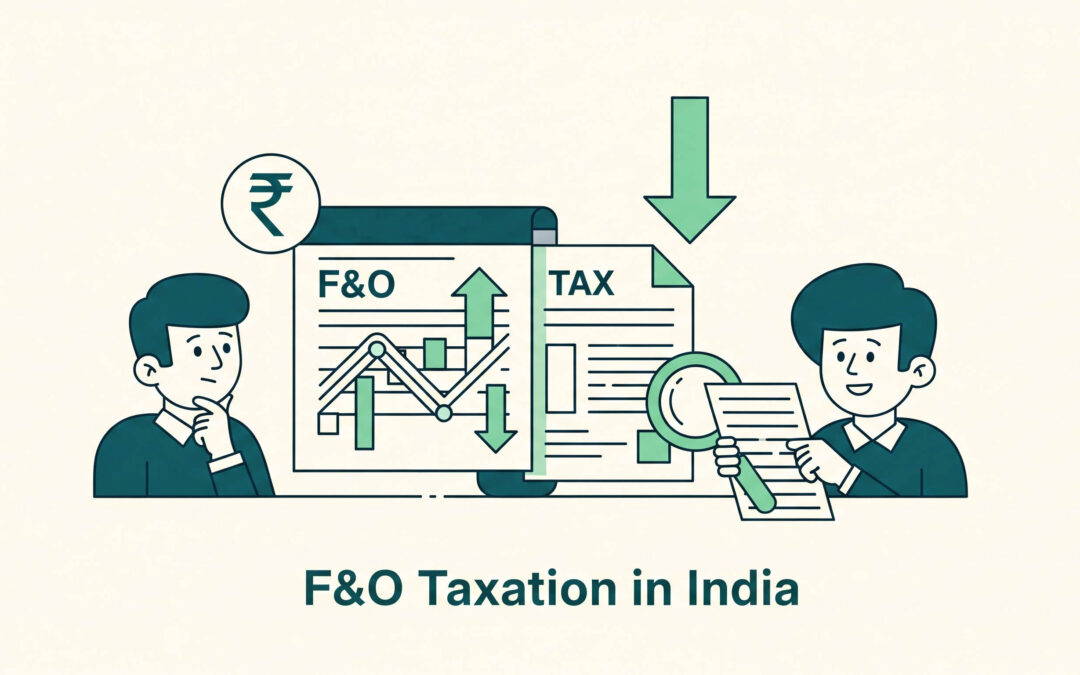The F&O trading is expanding in India, accounting for more than half of the total trade volume across the world. But, still, there are many individuals who lack a basic understanding of this aspect. Even some experienced investors are not well-versed in taxation policy. Understanding taxation holds great importance in order to set off losses and expenses and maintain the net returns.
This article will guide you on the taxation policy of F&O in India. Let us dive into the details for better understanding.
What is F&O Trading?
F&O trading is a contract between parties to execute the sell on a future date at a predetermined price. The trade can be of stocks, indexes, commodities, or currencies. Whether you are a full-time trader or a part-time investor, the money you make from it is considered business income for tax purposes in India.
Key Features:
- Contracts for Derivatives: F&O are derivatives whose value is based on underlying assets such as currencies, stocks, indices, or commodities.
- Leverage: By taking on big positions with comparatively little margin, traders can increase their gains and losses.
- Hedging Tool: It is a tool that lowers risk in case the value of underlying assets fluctuates, which may cause loss.
- Speculative Opportunities: Without actually owning the underlying asset, traders can profit from price changes.
- Standardised Contracts: The lot size, expiration date, and underlying are all the same for all F&O contracts that are traded on the NSE and BSE.
Participants in F&O can be divided into two main categories:
- All F&O trading income, whether positions are held for a very short period (including intraday) or carried forward for longer than a day, is classified as non-speculative business income under the Income Tax Act.
Despite involving market-linked securities, F&O’s income is categorised as non-speculative business income under the Income Tax Act. This classification affects the taxation and the ability to carry forward losses.
F&O Taxation in India 2025
F&O trading income is included in your gross total income and is subject to taxation at the rates of the relevant income tax slabs (under both old and new tax regimes). The breakdown is as follows:
1. Relevant Rates of Taxation
| Income Range | Old Regime | |
| Up to ₹2.5 lakh | Nil | |
| ₹2.5 – ₹5 lakh | 5% | |
| ₹5 – ₹10 lakh | 20% | |
| Above ₹10 lakh | 30% |
| Income Range | New Regime(as per FY 2024-25) | |
| Up to ₹3 lakh | Nil | |
| ₹3 – ₹6 lakh | 5% | |
| ₹6 – ₹9 lakh | 10% | |
| ₹9 – ₹12 lakh | 15% | |
| ₹12 – ₹15 lakh | 20% | |
| Above ₹15 lakh | 30% |
2. Needs for Audits
A tax audit under Section 44AB may be necessary if your F&O turnover exceeds ₹10 crore in a financial year, or exceeds ₹2 crore and you do not opt for presumptive taxation. A tax audit is also mandatory if your declared profits are less than 6% of turnover (for digital transactions) or 8% (for cash transactions) and your total income exceeds the basic exemption limit. Audits are required even in cases of low turnover if:
- Under presumptive taxation, profit is less than 6% of turnover.
- Section 44ADA applies only to professionals and does not cover F&O trading. For F&O traders, Sections 44AB (tax audit) and 44AD (presumptive taxation) are relevant.
3. F&O Turnover Calculation
For F&O, turnover differs from normal sales. This is how it’s calculated:
- Add the profit and loss from each trade for futures.
- Sum up the sale premium and the trade profit or loss for options.
Example:
| Trade Type | Buy Price | Sell Price | Premium | Turnover |
| Nifty 50 | Rs. 50,000 | Rs.55,000 | – | Rs.5,000 |
| BSE SENSEX | Rs. 2000 | Rs. 4,000 | Rs.2,000 | Rs.6,000 |
Returns and Deductions
Filing ITR-3 is mandatory for F&O traders (for business income). Deductions are available for costs incurred during trading, including:
- Commissions paid to brokers
- Internet-based bills
- Subscriptions for research
- Electricity or office rent (if operating from a rented space)
- Depreciation of trading-related assets
Loss Carry Forward:
- Non-Speculative F&O Losses: can only be deducted from business income and carried forward for eight years.
- Speculative losses are only deducted from speculative gains and can be carried forward for up to four years.
Bottomline
The conclusion can be drawn that it is important to understand the taxation of F&O in India to file the income tax returns and take advantage of the deductions available. This article provides the necessary information to assist you in providing a basic understanding of F&O trading.
Understanding the F&O taxation will benefit both full-time and part-time investors. The investors must know that the tax rate they are charged is according to the tax slab they fall under. Lacking the knowledge of important aspects, such as taxation, and the setting off of losses may result in a lowering of the net return.
Written by: Tanya Kumari


